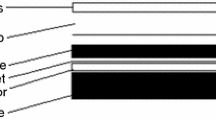Abstract
In the present study, a natural circulation thermosyphon flat plate solar water heater has been tested at the CDFD, Hyderabad (17.37°N, 78.43°E) Andhra Pradesh, India. Experimental data were noted on a sunny day. Dynamic response of the system to variations in solar insulation was studied and analyzed. T inlet °C and T outlet °C temperatures were recorded. The performance of the system can be improved by using aluminum tape inserts into the collector fins. The objective of the present study is to evaluate the performance of flat plate collector with and without inserts (aluminum strip of 1 mm thick, 3 mm width and 203 mm length). It is expected that with the same collector with the same flow rate, higher efficiency can be obtained by inserting the tapes inside the collector copper fins (9 mm). Thus, the cost of the system can be further bringing down by enhancing the collector efficiency.









Similar content being viewed by others
Abbreviations
- \( A \) :
-
Collector area (m2)
- \( F_{R} \) :
-
Collector heat removal factor
- \( I \) :
-
Intensity of solar radiation (W/m2)
- \( T_{\text{c}} \) :
-
Collector average temperature (°C)
- \( T_{\text{i}} \) :
-
Inlet fluid temperature (°C)
- \( T_{\text{a}} \) :
-
Ambient temperature (°C)
- \( U_{L} \) :
-
Collector overall heat loss coefficient (W/m2)
- \( Q_{\text{i}} \) :
-
Collector heat input (W)
- \( Q_{\text{u}} \) :
-
Useful energy gain (W)
- \( Q_{\text{o}} \) :
-
Heat loss (W)
- \( \eta \) :
-
Collector efficiency
- \( \tau \) :
-
Transmission coefficient of glazing
- \( \alpha \) :
-
Absorption coefficient of plate
- m :
-
Mass flow rate of fluid through the collector (kg/s)
References
Bello, S. R., & Odey, S. O. (2009). Development of hot water solar oven for low temperature thermal processes. Leonardo Electronic Journal of Practices and Technologies, 14, 73–84.
Duffie, J. A., & Beckman, W. A. (1991). Solar engineer ring of thermal processes. New York: Wiley.
Iordanou, G., (2009) Flate plate solar collectors for water heating with improved heat transfer for application in climatic conditions of the Mediterranean Region, Doctoral Thesis, Durham University. Available at Durham E Thesis online: http://ethesis.dur.ac.uk/174/.
Shepherd, D. W. (2003). Energy studies (2nd ed.). London: Imperial College.
Smith, C. (1995) History of solar energy revisiting, past solar power technology review.
Soteris, A. K. (2004). Solar thermal collectors and applications. Progress in Energy and Combustion Science, 30, 231–295.
Sukhatme, S. P. (1984). Solar energy-principle of thermal collection and storage. Delhi: Tata McDrew Hill Pub Co.
Author information
Authors and Affiliations
Corresponding author
Rights and permissions
About this article
Cite this article
Veeraboina, P., Guduri, Y. Performance analysis of solar water heating system in Centre for DNA Fingerprinting and Diagnostics (CDFD), Southern region of India. Environ Dev Sustain 16, 1223–1234 (2014). https://doi.org/10.1007/s10668-014-9523-z
Received:
Accepted:
Published:
Issue Date:
DOI: https://doi.org/10.1007/s10668-014-9523-z




